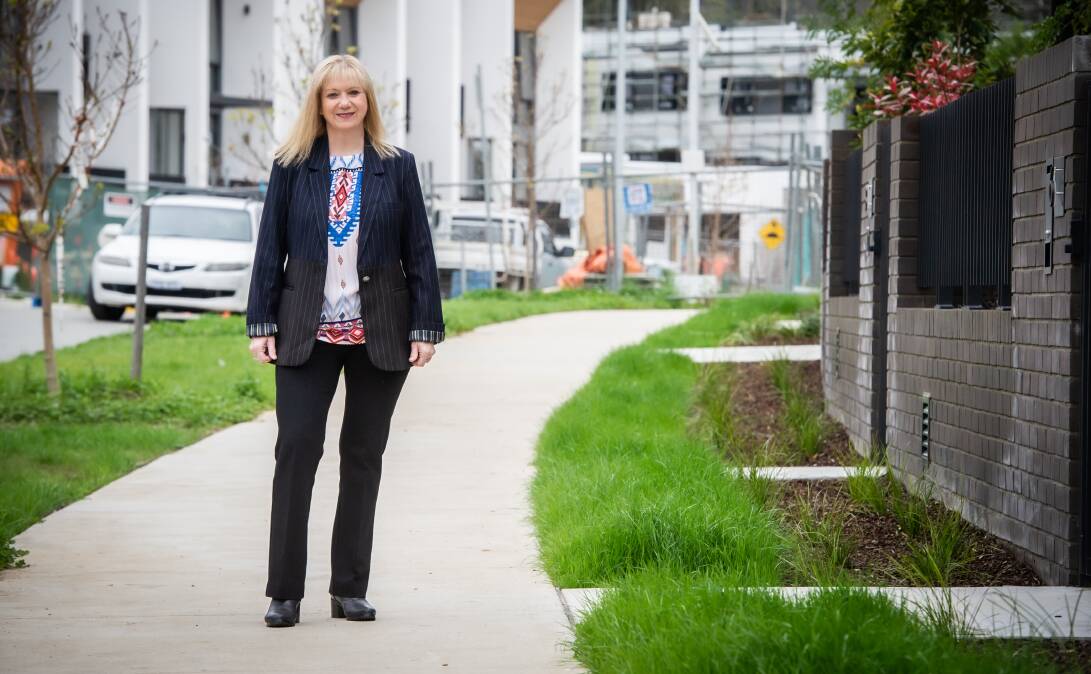
Jenny and Marcus Arnold picked up the keys to their new Canberra townhouse this month after relocating from Melbourne to be closer to their family.
They tossed up buying a detached house, but the idea was quickly scrapped.
"We did look into buying a standalone house but unfortunately you would have to go out into the suburbs to do that and that's just not where we were, at this point in our lives," Mrs Arnold said.
Instead, the pair have purchased a new-build terrace townhouse in Doma's The Parks development in Red Hill.
There was no compromise on size: the home has four bedrooms and is set over three levels.
The only thing missing is a backyard, but the development has that covered with several green spaces and a large, central park.
"You've still got the capability to go out for walks and enjoy the yards, as they would call them, we've got the parks right next to us," she said.
Better yet, there is no body corporate managing the townhouses.
"We're not restricted by anything that we can do in the house or so forth, which is a real bonus," Mrs Arnold said.
"I think that's the real winner for us."
Mrs Arnold said Canberra's inner suburbs could benefit from more townhouse developments.
"I do think that people can benefit from them," she said.
"They're not spending their time travelling, especially if they're needing to come into the city and they're living in the outer suburbs."
The Arnolds represent a growing number of Canberra home buyers who are opting for homes in urban infill areas, eschewing the detached home whether by choice or because a large block of land in established suburbs have become unaffordable.
The tension between demand for detached suburban housing and the need to house a fast-growing Canberra population is also one of the key issues of this Legislative Assembly term.
Chief Minister Andrew Barr has suggested a future of more "gentle urbanism" for Canberra: allowing more homes in established areas without resorting to high-rise towers.
Duplexes, walk-up apartment blocks and terrace housing is the kind of typology described as the "missing middle" in housing: the family homes between detached buildings and apartment towers.
The term originated in the United States, where it has been used to describe housing that was common before the Second World War but disappeared as urban sprawl and the car made detached housing the frequent first preference for family housing.
The Productivity Commission in September recommended governments change planning rules to allow more homes to be built in existing urban areas.
The commission's assessment of the national housing and homelessness agreement said relaxing some zoning rules could encourage higher density housing in residential areas, and encouraged governments to consider changing rules that allowed only single detached houses in certain zones, increasing the allowed density along transport corridors and relaxing rules that limit secondary dwellings.
The commission also recommended governments consider loosening minimum car park requirements in areas with access to public transport and minimum floor sizes for dwellings.
"Any changes to zoning regulation should balance the benefits of additional supply against costs to the environment, amenity and liveability of cities," the report said.
It's a recommendation backed by community groups like Greater Canberra, which told a Legislative Assembly inquiry earlier this year that RZ1 planning zones should allow unit-titled duplexes, triplexes and terraced housing on larger blocks.
The ACT government is currently in the process of reviewing and reforming its planning system, but there's been no suggestion the government could follow New Zealand's lead and allow wide-scale "upzoning" to increase housing density.
Much of the debate in Canberra has focused on whether a suburb's character will be affected if old homes are demolished to make way for taller buildings. (The current discussions echo angst about the densification of Kingston in the 1980s and Braddon in the 1990s.)
Indeed, architects have considered ideas to increase the density in some of Canberra's leafy inner-city suburban streets without losing the character.
But the the restrictions on much of the areas zoned for suburban housing mean these ideas stay as blueprints only.
The ACT government has argued a tight supply of new land for residential development has not greatly contributed to a rapid rise in housing costs in the capital, despite frequent protestations to the contrary from the Canberra Liberals.
"In a period of weak population growth from border closures, the recent strong house price growth in the ACT and across all of Australia has been driven by supportive fiscal policies and unprecedented expansionary monetary policy, including record low interest rates," the government has said.
While demand for new housing blocks remains high, those properties will be predominantly on Canberra's physical fringes.
The ACT government has bet others will want to live closer to the city and will choose other types of housing - once they know what it looks like.
Its challenge is building the new homes - and community support for them.
We've made it a whole lot easier for you to have your say. Our new comment platform requires only one log-in to access articles and to join the discussion on The Canberra Times website. Find out how to register so you can enjoy civil, friendly and engaging discussions. See our moderation policy here.






